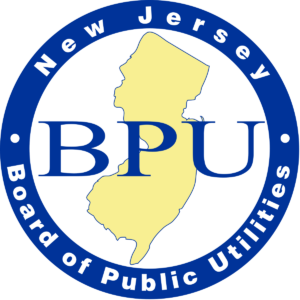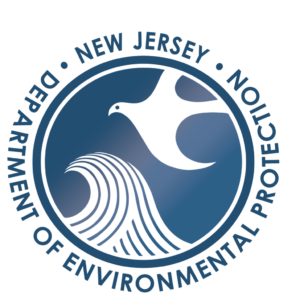
Research and Monitoring
The Offshore Wind Research & Monitoring Initiative (RMI) is a collaborative effort between the DEP and BPU that is working to coordinate and expand research into impacts of offshore wind development on wildlife and fisheries. Assessing potential interactions between marine mammals, including whales, and OSW is also a high-priority research need identified by the RMI.
Relevant projects include:
- Passive Acoustic Monitoring: The RMI is advancing a passive acoustic monitoring project to better understand the movements and behaviors of baleen whale species, including the endangered North Atlantic Right Whale, in the waters along New Jersey’s coastline. This project will be part of larger effort which includes collaboration with nearby state, regional, and federal entities that seeks to protect marine mammals as offshore wind farms are developed along the eastern seaboard.
- Continued operation of the whale-detection buoy currently located off the coast of Atlantic City, New Jersey adjacent to one of Ørsted’s wind energy development lease areas to (1) continue to educate all stakeholders about the capabilities of near real-time monitoring technology, (2) support the NOAA Slow Zones for Right Whales program in New Jersey waters, (3) assess how quickly detection data can be generated and delivered to stakeholders, and (4) foster dialogue about the appropriate use of the technology for mitigating risks associated with construction noise and vessel strikes during wind energy development activities.
- Gliders: (Autonomous under water vehicles that navigate the ocean) This program uses gliders to characterize baseline environmental conditions and how they might impact the distribution of marine species.
 The Board of Public Utilities (BPU)
The Board of Public Utilities (BPU)
Offshore Wind Solicitations require applicants to submit an Environmental Protection Plan (EPP) that describes all associated onshore and/or offshore environmental impacts from the planning, construction, and operation phases of the project.
The EPP must include:
- An analysis of the anticipated environmental benefits and environmental impacts of the project.
- A scientifically rigorous description of all associated environmental impacts from preconstruction activities through decommissioning including, but not limited to, environmental, water use, water quality, avian, marine mammals, sea turtle, noise, aesthetics, tourism, navigation, endangered species, sea-bed disruption of marine life, morbidity or mortality among avian, mammal or benthic populations, emissions of combustion byproducts to the air or oil or other toxic releases to the ocean, or solid waste generation.
- A plan for transparent reporting of findings related to impacts to marine mammals, sea turtles, and avian species.
- A description of the baseline and monitoring data that the Applicant intends to collect from preconstruction through decommissioning regarding the spatial and temporal presence of marine mammals, sea turtles, and avian species.
- A plan to address the identified impacts, including any innovative measures to avoid, minimize or mitigate impacts.
In addition, awarded projects in Solicitation 2 and 3 were required to commit financial and technical support to regional monitoring and research initiatives that explore the impact of the introduction of offshore wind projects on environmental conditions, wildlife, and fisheries for the New Jersey Research and Monitoring Initiative.
 New Jersey Department of Environmental Protection (DEP)
New Jersey Department of Environmental Protection (DEP)
As the trustee of the New Jersey’s natural resources, DEP evaluates any regulated development to ensure the ecological health of the ocean ecosystem and wildlife, including marine mammals.
DEP Permitting
DEP has authority over coastal zone management and related environmental assessment and permitting, which includes regulatory oversight of offshore wind energy infrastructure development in state waters, as well as related onshore activities. Within state waters and on regulated lands, the construction of associated facilities such as electrical substations, and the installation of cables and transmission lines will likely require several DEP permits including one or more of the following: a Coastal Area Facilities Review Act permit; Waterfront Development permit; Freshwater Wetlands permit; Coastal Wetlands permit, Flood Hazard Area Control Act permit, Water Quality Certificate under Section 401 of the Clean Water Act; and a Tidelands Conveyance.
Federal Consistency
In the United States, the Federal Bureau of Ocean Energy Management (BOEM) regulates renewable energy activities on the Outer Continental Shelf (OCS). In New Jersey, Federal waters commence 3 nautical miles offshore our coast, as a result, BOEM has been facilitating lease sales of OCS blocks for the development of offshore wind energy facilities. For more information on the status of the wind projects offshore visit BOEM’s New Jersey Activities.
Importantly, the DEP also review offshore wind projects for consistency pursuant to the Coastal Zone Management Act (CZMA). The CZMA establishes a formal review process commonly known as federal consistency review. Federal consistency provides an opportunity for states to review federal agency activities which have reasonably foreseeable effects on any land or water use, or natural resource of the coastal zone, to ensure consistency with the enforceable policies of a State’s federally approved Coastal Management Program. DEP will review offshore wind projects for federal consistency during a project’s environmental review period.